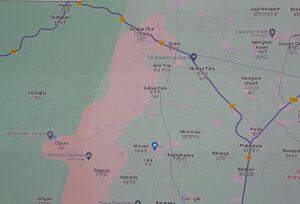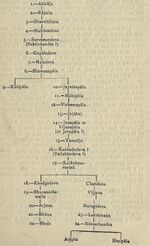Chaura Kawardha
- For clan see Chaura
| Author:Laxman Burdak, IFS (R) |


Chaura (चौरा) is a village in Bodla tehsil of Kawardha district in Chhattisgarh. It is about 11 miles from Kawardha. Famous Bhoramdeo Shiva temple is situated here. Author (Laxman Burdak) visited it on 16.04.1985 while on way from Raipur - Jabalpur.
Variants
- Chavarapura/Chavarāpura - Mentioned in Mandava Mahal Inscription of Ramachandra of Phani Nagavanshi kings of Samvat 1406 (A. D. 1349) at Chaura
Jat Gotras Namesake
- Chaura = Chaura Kawardha, a village in Bodla tehsil of Kawardha district in Chhattisgarh. It is about 11 miles from Kawardha. Famous Bhoramdeo Shiva temple is situated here. Author (Laxman Burdak) visited it on 16.04.1985 while on way from Raipur - Jabalpur.
Location

It is situated 11km away from sub-district headquarter Bodla (tehsildar office) and 16km away from district headquarter Kawardha. According to Census 2011 information the location code or village code of Chaura village is 439403. Chaura village is located in Bodla tehsil of Kabeerdham district in Chhattisgarh, India. It is situated 11km away from sub-district headquarter Bodla (tehsildar office) and 16km away from district headquarter Kawardha. The total geographical area of village is 173.58 hectares.[1]
Genealogy

Mandava Mahal Inscription of Ramachandra of Phani Nagavanshi kings of Samvat 1406 (A. D. 1349) at Chaura
Source - Hira Lal: Descriptive lists of inscriptions in the Central provinces and Berar,p.162-63
Chaura is a village about 11 miles from Kawardha. In a temple known as Mandava Mahal (मंडवा महल) there is a long inscription on a slab containing 37 lines, which records the construction of a Siva temple by king Ramachandra, born of the Phani or Nagavansha, and married to Ambikadevi of the Haihaya lineage. It gives the legend of the origin of the Nagavansha, somewhat resembling that of the Haihaya-vansha, who claim a serpent and a mare to be their original ancestors. Our record relates that a serpent got enamoured of Mithila, the beautiful daughter of the sage Jatukarna (जाटुकर्ण).

He therefore assumed human form and had intercourse with her. Their issue was Ahiraja, who, having conquered the neighbouring chiefs, set himself up as a king. The kings who followed him are shown in the genealogical table in the picture. Family tree is as under:
1. Ahiraja → 2. Rajalla → 3. Dharnidhara → 4. Mahimadeva → 5. Sarvavandana (Saktichandra ?) → 6. Gopaladeva → 7. Naladeva → 8. Bhuvanapala → 9. Kirtipala → 10. Jayatrapala → 11. Mahipala → 12. Vishamapala → 13. Ja(nhu) → 14. Janapala or Vijanapala (or Juvapala ?) → 15. Yasoraja → 16. Kanhadadeva ? (Vallabhadeva ?) → 17. (La)kshmavarma → 18. Khadgadeva → 19. Bhuvanaikamalla → 20. Arjuna → 21. -Bhima → 22. Bhoja
17. (La)kshmavarma → Chandana → Vijjana → Malugideva → 23 Lakshrtiana → 24. Ramachandra → (Arjuna + Haripala)
It would appear that the succession deflected twice from the direct line. For nine generations up to Kirtipala it went in a direct line. The 10th king Jayatrapala was a brother of Kirtipala, who apparently had no son to succeed him. Twelve descendants of Jayatrapala succeeded one after the other, the last king Bhoja being succeeded by Lakshmana, a great-grandson of his great-great-grand-uncle. Lakshmana's son was Ramachandra, the 2Oth descendant from the original ancestor Ahiraja.
The inscription is dated in Vikrama Saka 1406, bearing the name Jaya, which makes it clear that the year intended was that of the Vikrama era, as the cyclic year Jaya was current in Vikrama Samvat 1406 (A. D. 1349).
This record shows that Kawardha and the neighbouring country were under the sway of the Nagavanshi kings for a period of about 500 years, commencing from the beginning of the 9th Century A. D., a little before the advent of the Kalachuris or Haihayas to Chhattisgarh.
Apparently the Nagavanshis became the feudatories of the Kalachuris and continued to rule under their protection for a long time. Amongst the kings of this dynasty we find two names Gopaladeva (6) and Yasoraja (15) with which we are familiar from other inscriptions found in this locality. Gopaladeva's name occurs in the Boramdeo temple, about a mile away from our inscription slab. It is dated in the Kalachuri year 840, or A. D. 1088, while at Sahaspur, only 21 miles away from Chaura, there is a record of Yasoraja, dated in the Kalachuri year 934, or A.D. 1182. These kings must evidently belong to the dynasty which our record describes. Between Gopaladeva and Yasoraja there was an interval of only 94 years according to the dates of their inscriptions, but our record gives eight intervening generations, giving an average of less than 12 years to a generation. This throws a doubt on the accuracy of the genealogy, to swell which it is possible a number of fictitious names may have been inserted.
The geographical names mentioned in the record are Chavarāpura, the Samkari river, Rajapura and Kumbhipuri.
Chavarapura, to the east of which the temple was built, is undoubtedly the village Chaura, within whose limits the temple still lies, and Samkari is the Sankari river which is about a quarter of a mile away.
Rajapura was a village granted for the supply of offerings to the god, and may be identified with a village of the same name three miles from Chaura.
Kumbhipuri is not traceable. It was given at the same time as an agrahara to a Brahman named Mahesa.
The record which is in verse, was composed by a Dakshini Brahman Vitthala, which seems to account for the curious way in which he has indicated the era, calling it Vikrama Saka ; the last word Saka used in this phrase is merely an equivalent of a year.
Polpulation
Chaura has a total population of 390 peoples, out of which male population is 191 while female population is 199. Literacy rate of chaura village is 37.95% out of which 43.98% males and 32.16% females are literate. There are about 100 houses in chaura village. Pincode of chaura village locality is 496445. Kawardha is nearest town to chaura for all major economic activities, which is approximately 16km away.[2]
See also
References
Chaura in Patiala
Chaura is also the name of a village in Patiala district of Punjab (under Patiala Tahsil).
References
Back to Inscriptions

